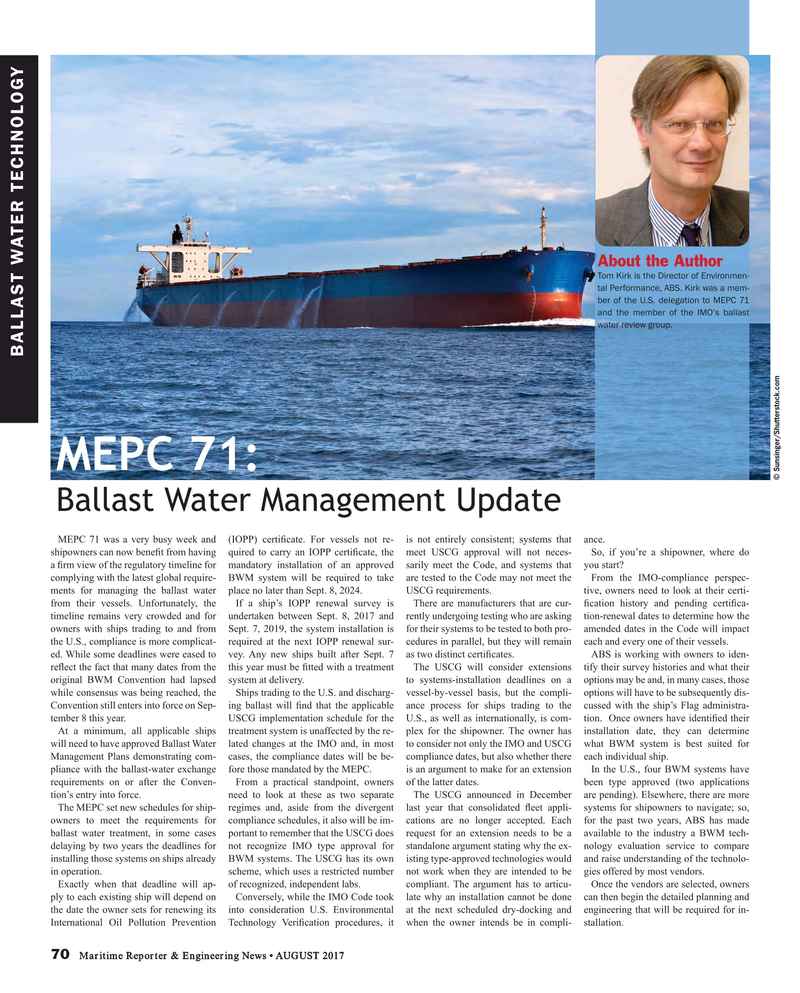
Page 70: of Maritime Reporter Magazine (August 2017)
The Shipyard Edition
Read this page in Pdf, Flash or Html5 edition of August 2017 Maritime Reporter Magazine
About the Author
Tom Kirk is the Director of Environmen- tal Performance, ABS. Kirk was a mem- ber of the U.S. delegation to MEPC 71 and the member of the IMO’s ballast water review group.
BALLAST WATER TECHNOLOGY
MEPC 71: © Sunsinger/Shutterstock.com
Ballast Water Management Update
MEPC 71 was a very busy week and (IOPP) certi? cate. For vessels not re- is not entirely consistent; systems that ance.
shipowners can now bene? t from having quired to carry an IOPP certi? cate, the meet USCG approval will not neces- So, if you’re a shipowner, where do a ? rm view of the regulatory timeline for mandatory installation of an approved sarily meet the Code, and systems that you start? complying with the latest global require- BWM system will be required to take are tested to the Code may not meet the From the IMO-compliance perspec- ments for managing the ballast water place no later than Sept. 8, 2024. USCG requirements. tive, owners need to look at their certi- from their vessels. Unfortunately, the If a ship’s IOPP renewal survey is There are manufacturers that are cur- ? cation history and pending certi? ca- timeline remains very crowded and for undertaken between Sept. 8, 2017 and rently undergoing testing who are asking tion-renewal dates to determine how the owners with ships trading to and from Sept. 7, 2019, the system installation is for their systems to be tested to both pro- amended dates in the Code will impact the U.S., compliance is more complicat- required at the next IOPP renewal sur- cedures in parallel, but they will remain each and every one of their vessels.
ed. While some deadlines were eased to vey. Any new ships built after Sept. 7 as two distinct certi? cates. ABS is working with owners to iden- re? ect the fact that many dates from the this year must be ? tted with a treatment The USCG will consider extensions tify their survey histories and what their original BWM Convention had lapsed system at delivery. to systems-installation deadlines on a options may be and, in many cases, those while consensus was being reached, the Ships trading to the U.S. and discharg- vessel-by-vessel basis, but the compli- options will have to be subsequently dis-
Convention still enters into force on Sep- ing ballast will ? nd that the applicable ance process for ships trading to the cussed with the ship’s Flag administra- tember 8 this year. USCG implementation schedule for the U.S., as well as internationally, is com- tion. Once owners have identi? ed their
At a minimum, all applicable ships treatment system is unaffected by the re- plex for the shipowner. The owner has installation date, they can determine will need to have approved Ballast Water lated changes at the IMO and, in most to consider not only the IMO and USCG what BWM system is best suited for
Management Plans demonstrating com- cases, the compliance dates will be be- compliance dates, but also whether there each individual ship.
pliance with the ballast-water exchange fore those mandated by the MEPC. is an argument to make for an extension In the U.S., four BWM systems have requirements on or after the Conven- From a practical standpoint, owners of the latter dates. been type approved (two applications tion’s entry into force. need to look at these as two separate The USCG announced in December are pending). Elsewhere, there are more
The MEPC set new schedules for ship- regimes and, aside from the divergent last year that consolidated ? eet appli- systems for shipowners to navigate; so, owners to meet the requirements for compliance schedules, it also will be im- cations are no longer accepted. Each for the past two years, ABS has made ballast water treatment, in some cases portant to remember that the USCG does request for an extension needs to be a available to the industry a BWM tech- delaying by two years the deadlines for not recognize IMO type approval for standalone argument stating why the ex- nology evaluation service to compare installing those systems on ships already BWM systems. The USCG has its own isting type-approved technologies would and raise understanding of the technolo- in operation. scheme, which uses a restricted number not work when they are intended to be gies offered by most vendors.
Exactly when that deadline will ap- of recognized, independent labs. compliant. The argument has to articu- Once the vendors are selected, owners ply to each existing ship will depend on Conversely, while the IMO Code took late why an installation cannot be done can then begin the detailed planning and the date the owner sets for renewing its into consideration U.S. Environmental at the next scheduled dry-docking and engineering that will be required for in-
International Oil Pollution Prevention Technology Veri? cation procedures, it when the owner intends be in compli- stallation. 70 Maritime Reporter & Engineering News • AUGUST 2017
MR #8 (66-73).indd 70 MR #8 (66-73).indd 70 8/7/2017 2:49:33 PM8/7/2017 2:49:33 PM

 69
69

 71
71
